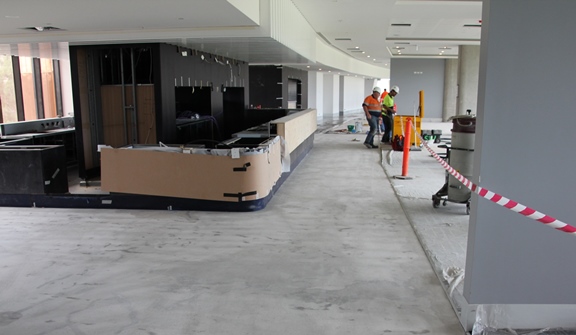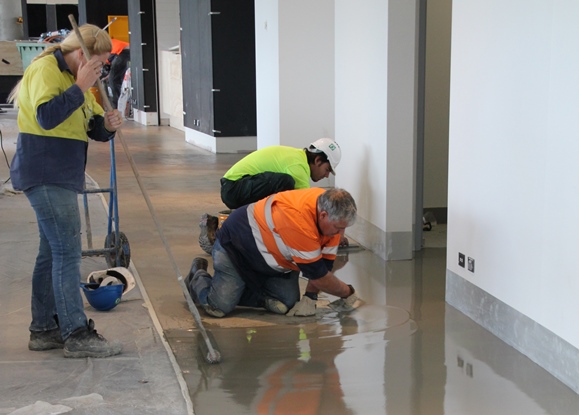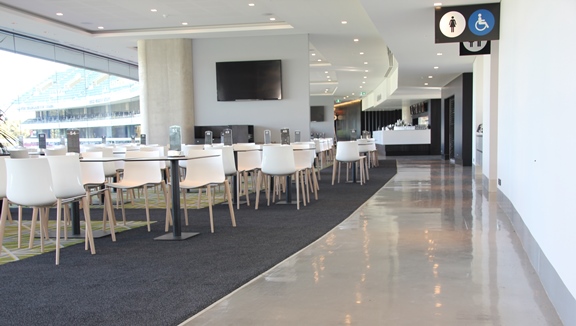For nearly 150 years, the Adelaide Oval in South Australia has served as a haven for local sports and entertainment. The facility is currently home to two Australian Football League (AFL) teams — Adelaide Crows and Port Adelaide — and it also hosts concerts and marquee games of cricket, rugby, and soccer.
But events over all those years took a cumulative toll, with major maintenance required to give modern flair to the legendary facility. In addition, AFL officials mandated significant upgrades to seating capacity and infrastructure to host its franchises. Rather than build a new stadium at massive cost, the South Australian government committed in 2009 to a ~$450-million redevelopment project to spruce up the stadium.
As part of the project, luxurious entertainment options were a priority. Plans were developed for a club area, bar room, and restaurant — but to make it all come together, the architect needed a stylish, seamless, easy-to-clean concrete surface. Enter FLOORChef, a regional coatings contractor with a network of 20 contractors around the country.
“They wanted a stylish floor that could be colored to match the décor as well as handle a testing mix of corporate catering and heavy traffic,” said FLOORChef’s Managing Director Jack Josephsen.
Specifications called for a custom-colored, two-tone design to match the décor of each room. The design also incorporated some deliberate blemishes to provide a more forgiving look for the high-traffic areas. In all, the project entailed ~7,430 square feet (~690 m2) of flooring to coat, with each room taking a week to complete.
Preparing the Team
The project was completed near the end of the Australian summer, so temperatures were high and curing times were quick — typically within hours. It was all indoor work, so rain and wind were not issues; however, the vast construction zone could not be fully sealed, which meant bugs could occasionally land in the wet film.
As part of the larger redevelopment, other trade contractors were working in close proximity, so the use of solvent-borne coatings was not an option. Instead, the crew used solvent-free ArtEpoxy resins made by Real World Epoxies. The chosen epoxy resins did not have offensive odors or flammability risks.
FLOORChef utilized a four-person crew for the project, with two master tradesmen conducting the actual application of the coating system. Another detail of workers were mixing, carrying, cutting in, and performing other assorted duties. While Josephsen served as project director at the site, he also wasn’t afraid to gets his hands dirty with the crew when needed!
“I was there to ensure the project was delivered on time, on budget, and to the standard we expect,” Josephsen said. “I’m very much a hands-on supervisor, though, and like to get actively involved in the application process.”

Before each day’s work, every crew member put on full personal protective equipment (PPE) including long-sleeved shirts, pants, steel-capped boots, gloves, safety glasses, and dust masks. Hard hats were also required, since the stadium was a construction site and some overhead work was being done. Because solvent-borne systems were not used, though, organic vapor masks were not needed.
Executing the Game Plan
The crew essentially divided the 21-day assignment into three week-long stints, working one room at a time. They started with the club room, which offers patrons a glimpse into the football locker rooms, and then they repeated the process for the bar room and restaurant, respectively, with some minor variations based on the unique properties of each room.
Before applying the coating system, some grinding and leveling work was required to smooth areas of the existing concrete flooring where peaks and troughs were too large, including ramping in doorways. Even though the project was indoors, the crew opted to use an outdoor leveler — the Exterior Leveller 16 from RLA Polymers — because of conditions in areas adjacent to toilets and kitchens. Patching of various cracks, joints, and gouges was also completed at this stage.
Once the concrete was prepared, the crew was ready to apply the new system! The same ArtEpoxy Resin PAX was used for the basecoat and topcoats. Specifications called for the resin in “Mt Eden” gray color for the club room, “Teahouse” gray in the bar room, and “Organic” gray for the restaurant.

Using an 18-in. (45.7 cm) Magic Trowel by TexMaster Tools — a wide, squeegee-like tool with a rubber, flexible blade — the basecoat was applied at an average of 13 mils (330.2 microns) and then backrolled with 11-in. (27.9 cm) rollers to even it out further. At this film thickness, the resin could be applied over the leveler without the need to seal first. Another coat was then put down with the same specifications to ensure the system had an even film with good opacity across the entire space.
To apply the decorative topcoat, the crew drizzled black pigment into a clear coat of the ArtEpoxy resin. The topcoat was also applied with a Magic Trowel and backrolled, but at an average thickness of 16 mils (406.4 microns). Once applied, crew members walked back onto the wet floor with spiked shoes, drizzled the pigments more, and gently blended to soften the effect. The floor was then left to flow and flatten out without further rolling.
Around the bar areas, an additional coat of Duraglaze — the company’s clear, non-slip topcoat — was applied using a sponge roller. Duraglaze is comprised of the ArtEpoxy resin and a proprietary stir-in, non-slip particle.
“This type of finish is ideal for decorative floors because it doesn’t interfere with the design underneath,” Josephsen said. “It can be dry or wet-mopped, it improves scratch and scuff resistance, and it adds to patron safety in the event of spills or splashes.”
The areas not given the Duraglaze treatment were given three coats of the Satin Star finish polish from the Research Products division of Oates Laboratories. That satin finish polish was the start of an ongoing maintenance program developed for the three rooms.
Winning Points
The crew had a high sense of urgency to wrap up the project, since the field itself was already being used for a domestic cricket match during the final week of work! In addition, specifications called for full project completion by the first game of the AFL season in March, and FLOORChef’s portion did not begin until the final month before that season opener.
But even with a tight timetable, the experienced crew got the job done, and the revitalized stadium was able to open on schedule. Hames Sharley Architects, the architectural firm for the project, and Wetspot Consolidated P/L, principle coating contractor, graded FLOORChef’s work as a 9 out of 10 and a 10 out of 10, respectively.
“As a manufacturer, it’s deeply satisfying to create a flooring system from scratch and watch it being applied on a large scale by contractors who actually enjoy the process,” Josephsen said. “To then be rewarded for a fantastic team effort with 9s and 10s from the architect and client was just cream on the cake.”
